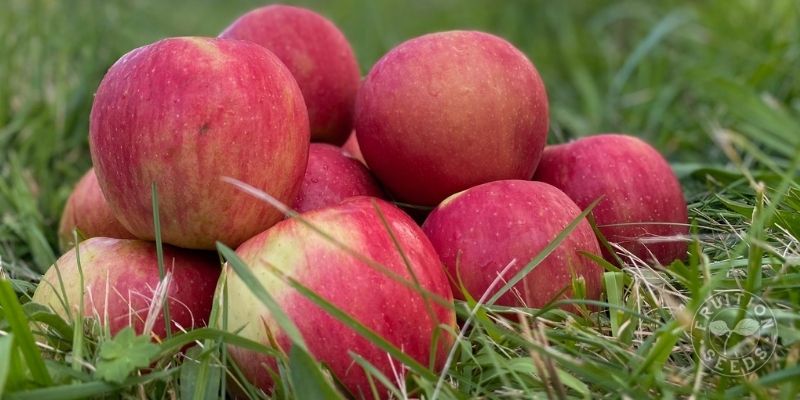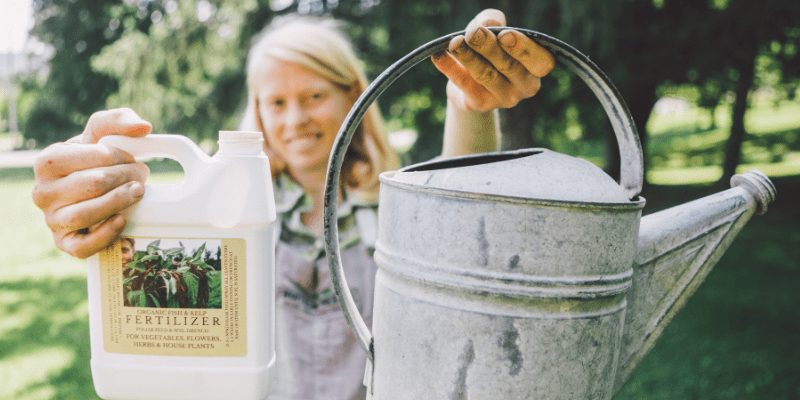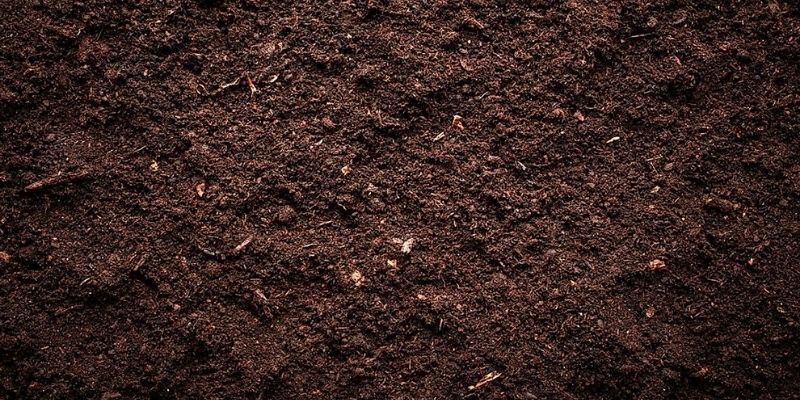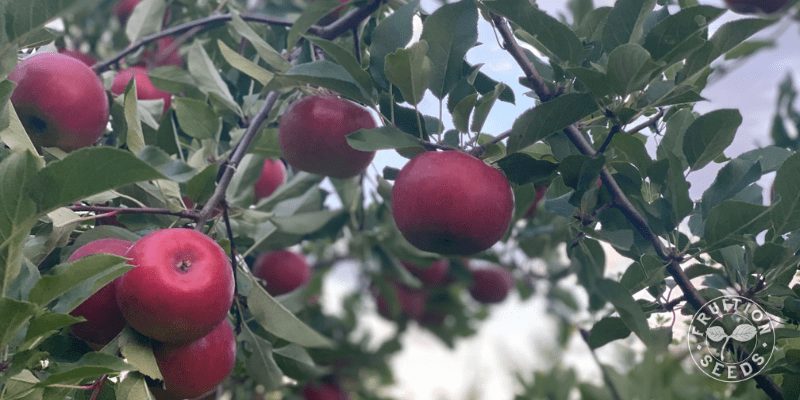
Enjoy Fruition's
Organic Apples & Orcharding Course!
Fruition’s free course shares dozens of video tutorials to surround you with abundance for seasons to come.
We look so forward to joining you on the journey!
Soil Testing for Trees & Orchards
By Lauren Cormier
Friends, whether you’re planting one tree or many, the cost of a soil test is a small price to pay for the precision of soil building possible with its insight. Especially if you don’t need to do much amending! But if you do, there is no sharper tool in your tool box.
Even if you only plan to plant a single tree, a soil test is a crucial first step prior to planting. Hop on over to our Soil Testing Made Simple blog to learn how!

What to Expect from Your Soil Test
Your soil test will return to you with specific amendment recommendations, so be sure to include, along with your soil sample, that you’re planning to plant apple trees in the future. Squash, blueberries and trees have very different needs and the recommendations made based on your soil test will be particular for your dreams.
And Friends, soils are complex! Teeming with fungi, bacteria, protozoa, insects and earthworms, soil is a continuum of life and decay bringing vital nutrients to your trees. A healthy soil food web is rich with microbial activity and has beneficial organisms to prevent harmful pathogens. But this won’t directly show up on the soil test! So we need to keep this important piece in mind when we’re thinking about our orchards. There’s so much more to share and soon we shall.

What’s Being Tested?
In the meantime, let’s dive deeper into the dynamics of soil testing. The essential macronutrients tested are calcium, magnesium, nitrogen, phosphorus, potassium, and sulphur. Your soil test will also indicate pH level, percentage of organic matter, total exchange capacity, and micronutrient levels.
Soil test results are measured in acreage, which is still a great gauge to understand what is needed (or in excess) at a small scale. In many cases, we don’t need to get too caught up in exact measurements (thank goodness!) and we’ll share our approaches to proportions and ratios at a small scale below.
It’s All Relative
It’s true, different soil tests offer different analysis approaches. That being said, most often each nutrient is classified as very high, high, medium, low or very low.
We’ve found it’s only necessary to address ‘very low’ deficiencies and Friends, it’s best to begin addressing it as soon as possible.

Soil Tested: What’s Next?
Once we’ve received our soil test, it may be a little difficult to know exactly how much of each amendment to apply to each individual tree since amendment recommendations are most often shared in pounds or tons per acre. Since most of us are not planting large orchards, we use the soil test as a guideline, giving us perspective on an overall strategy for long-term improvement. We apply amendments mixed in with our compost in smaller amounts so the trees aren’t getting too much at one time. We share our base recipe below!
And Friends, our overall approach is slow and steady, rather than too much all at once. As we’re establishing our trees, we test annually each year so we can track improvement and adjust future amending. After our soil has consistent quality, we test every 2 to 3 years.
Now let’s take a look at the soil test from the perspective of an apple tree!
Calcium, pH & Soil Testing
Calcium levels should ideally not be below 2000 pounds per acre. Calcium levels affect the pH in the soil, which can be either acidic, neutral, or alkaline. With 7 being neutral, any pH below that is considered acidic, and anything above is alkaline. Soil pH is ideally between 6 and 7 in an orchard, though a little higher than 7 is okay. When calcium is low, the cell strength and fruit membranes in the skin can be weakened, fruit will bruise more easily, and won’t store as well. Low calcium also leaves fruit more susceptible to a common disorder called Bitter Pit, affecting the quality and storage potential.
If pH is low, lime should be added annually until pH has reached the desired level. It usually takes 2 to 3 years to become fully active, though some immediate benefits may be seen. For backyard plantings, relatively little is needed and each liming amendment will come with its own application instructions. Which lime amendment to choose? This comes down to magnesium levels as well as your pH baseline. Dolomitic limestone, calcitic limestone, carbonized limestone, and gypsum are all a little different; the presence/absence of magnesium in your soil test will help you determine which one is right for you.
If you’re planting a larger area that needs significant lime, it is advised to not add more than 2 tons per acre in the first year, as it needs to gradually integrate into the soil. If more is needed after the first year, it is generally recommended to only add between 200 to 400 pounds per acre each year until your pH goals are reached.
Nitrogen & Soil Testing
Unlike squash and many vegetables, nitrogen is not needed in substantial quantities for apple trees. Ideally, their nitrogen requirements are largely satisfied with a rich layer of organic matter decaying on the soil surface. We’ll dig into this more below!

Too much nitrogen creates excessive vegetative growth that doesn’t sustain fruit production or full hardening off for winter. It’s true, only a small portion of nitrogen that exists in the soil is in a form that is readily available to plants, and for fruit trees, that is often enough.
Nitrogen levels are directly tied in with the percentage of organic matter on the soil test. Organic matter supplies nitrogen through a process called mineralization as it breaks down. Organic matter is approximately 5% nitrogen with only 2 to 4% actually being mineralized into a form available to trees each year. A soil with 3% organic matter might equate to producing approximately 60 pounds per acre of available nitrogen for trees, and a soil with 5% organic matter can produce up to 120 pounds per acre.
When nitrogen is needed, it is best applied in the form of compost where it is naturally balanced with other elements. Fruition shares organic compost on our website as well as scoop-your-own from a small mountain of black gold at our Garden Store in spring! If compost is unavailable or not economical, then fish meal, alfalfa meal and/or soybean meal can be used to boost nitrogen levels, as well.

A word of caution about nitrogen: When applied in excess or disproportionate levels to other nutrients, nitrogen can set the stage for pathogens and disease. When nitrate-based chemical fertilizers, as well as sulphur and copper sprays, are used consistently year to year, the soil can become saturated with nitrogen over time, shifting it away from being a fungal dominated soil. For this reason, sulphur and copper sprays should be used as sparingly as possible. Thank goodness for disease resistant varieties that don’t need all the fuss!
Phosphorus & Soil Testing
Phosphorus levels should be at least 200 pounds per acre. One of the most vital nutrients for trees, phosphorus is essential for root development. Phosphorus and other hard-to-mineralize nutrients are often made available to tree roots from the assistance of mycorrhizal fungi, a very close friend and collaborator of trees for hundreds of millions of years. More on this symbiosis to come!
If your soil has less than 200 pounds of phosphorus per acre, it may take a few years before fungal activity is built up enough for phosphorus to be fully accessible to tree roots. To give an initial boost of phosphorus to your establishing trees, 1 to 2 pounds (1 to 2 quart-sized yogurt containers) of powdered, available and slow-acting rock phosphate can be spread around trees at the time of planting.

To incorporate rock phosphate, we mix the powder with a wood chip-based compost in the proportion of one or two quart-sized yogurt containers of rock phosphate mixed with one wheelbarrow full of compost. Depending on soil test, each tree can get a half to full wheel barrow load of the mixture. Spread wood chip mulch right on top (giving the trunk a few inches to breathe) to provide extra fungal organic matter, and thus available phosphorus, throughout the season.
If you’re building soil with abundant wood chips and compost, this may well be the only time you supplement phosphorus for your trees, though if more is still needed, it can be applied on an annual basis until adequate levels have been reached.

Some common rock powders include Tennessee brown phosphate, colloidal phosphate, and bonemeal, the most soluble form of organic phosphorus.
Also, alkaline soils with excessive calcium and magnesium can tie up phosphorus; in this case, soils need to become slightly more acidic rather than phosphorus levels increased.
Potassium & Soil Testing
Like phosphorus, potassium levels are optimally 200 pounds per acre or more. Potassium affects fruit color, size, quality and hardiness. Potassium levels need to be watched carefully to maintain desired levels and will decrease when crops begin to be harvested each year. If potassium is low, it can be added to the soil in wood ash, greensand, K-mag, granite dust, and sulfate of potash.

Micronutrients & Soil Testing
Though they’re commonly referred to as ‘micro’ nutrients, make no mistake: calcium, iron, manganese, boron, molybdenum, copper, zinc, and chlorine are essential minerals. Needed only in small amounts, the effects of their absence are dire. If such deficiencies are noted in your soil test, adding kelp meal and azomite will supply a vast spectrum of minerals, which is often better for trees than amending any one specifically.

Elemental Balance & Soil Testing
As we evaluate a soil test, nutrient levels are important both on their own as well as their relative proportion to calcium. Here are some of the most important relationships to keep in mind:
Calcium to Magnesium ratio (Ca:Mg) Soil texture affects so much more than simply water drainage! For example, your Ca:Mg ratio will be different depending on what type of soil you’re working with. Essentially, the heavier the soil, the more calcium that will be needed to push soil particles apart for improved drainage and aeration. As a rough guide, the goal for sandy soil would be 5:1, loam 7:1, and clay 9:1. Magnesium has the opposite effect and pulls particles together, making it beneficial for sandy soils.
Calcium to Potassium (Ca:K) Trees thrive when the Ca:K ratio is no greater than 14:1.
Calcium to Magnesium to Potassium ratio (Ca:Mg:K) This trio ideally hovers around 70:12:4 for loam soil, 65:17:3 for sandy soil. and 76:10:5 for clay soil.

Soil Testing with Our Eyes
Soil tests tell us a lot and watch your plants: They are telling you a great deal, too! Deficiencies play out in different ways and can be detected by visual signs on leaves and buds, like yellowing and shriveling. Deficient nitrogen, for example, is often evidenced in pale, yellowing leaves and branches with short terminal growth. If leaves have distinct yellowing along the edges that almost looks burnt, it’s likely low potassium levels. However, magnesium deficiency might also reveal itself through yellowing along leaf margins, but also in the veins too. Some deficiencies have similar looking symptoms so it’s important to compare visual signs to a recent soil test and fertilization records before jumping to conclusions.
And Friends, don’t be too hasty! Similar to blossom-end rot in tomatoes often being a water deficiency resulting in a calcium deficiency even when calcium is otherwise abundant in your soil (there’s so much more to say!), a calcium deficiency in fruit (such as bitter pit) may too evidence environmental factors rather than indicate a true soil deficiency. Which is why soil tests and visual analysis are both critical tools to be used in tandem.

Soil: It’s All About The Duff
Soil with 3 to 5% organic matter (OM) or more is optimal for trees and will provide sufficient nitrogen needed for the orchard. If the OM percentage is lower than 3%, then compost and wood chips can be added around trees over time. As organic matter breaks down, it increases the capacity of the soil to hold water, much like a sponge.
The higher the percentage of organic matter in the soil, the higher the Cation Exchange Capacity (CEC) will be. Cations are soil elements with a positive electrical charge. The CEC is the capacity of the soil to hold essential nutrients from leaching off. It affects both soil structure and acidification. The CEC number on a soil test will vary depending on the soil type and is instrumental in gauging the amount of organic matter needed to build up soil. Generally the CEC falls within the following range based on porosity of the soil: sandy soils 3 to 7, loam soils 8 to 14, clay soils 15 or more.
CEC also governs the ratios needed for important nutrients- calcium, magnesium, and potassium. When possible, get a soil test that uses percent base saturation to determine acidity in the soil. Percent Base Saturation is the percentage of the Cation Exchange Capacity (CEC) to hold cations (positive ions) of calcium, magnesium, and potassium within the soil structure where they are accessible to plants. A higher percent base saturation means a higher pH and less acidification.It is vital that soils have the correct proportions of these cations (nutrients) in relation to one another, or Cation Balance. If the ratio is off by a lot then some nutrients can be blocked from absorption, or locked up, as a result of the imbalance.

Soil Test for Garden as well as Orchard
The nutrient requirements for trees are different from annuals, so it’s a good idea to have two separate tests for garden and orchard. Annuals benefit from a bacterial-dominated soil which occurs from the breakdown of straw, hay, and cover crops. On the other hand, trees prefer a fungal dominated soil similar to that of the woods. Apples, like other trees, benefit from the breakdown of leaves, bark, and wood. Found amongst the forest duff, mycelial fungal networks can be seen running like cobwebs through the soil. Mycelium works in what is called a “mycorrhizal symbiosis” with tree roots to absorb nutrients, a mutually beneficial partnership for both fungi and tree. There’s so much more to share and soon we shall!
Think Beyond the Soil Test
While the soil test is incredibly important, it can’t begin to measure the complex biological activity happening within this mycorrhizal area extending out far beyond the physical root systems of the trees. Orchard health generates from this magical place. Our goal is to create a similar decomposition of woodsy organic matter so there is plenty of mycelium to go round.
The compost and wood chips spread at planting time play an important role in creating organic matter needed for tree health. Most of the nutrients taken up by the tree will be coming from above the soil rather than deep down below. A woody layer of debris, also called duff, can be maintained in the long-term to provide nutrients in the correct proportions needed for absorption as it slowly breaks down and decays. This layer can include mulching with wood chips, leaves, compost, and clippings from herbaceous companion plants.
When organic matter breaks down, it creates a stable level of dark, carbon-rich soil called humus made up of lignin, sugars, acids, and fats. Building up the humus level is key to soil fertility and the ultimate goal in orchard soil health. In forest ecosystems, where apples grow in the wild, there is a thick layer of humus just below the decaying leaves. Where soil is poor or lacking in organic matter, humates can be added at the time of planting to increase biological activity where CEC is low and in need of a jump start. Humates can be especially beneficial for sandy soils.

How to Apply Amendments
Depending on our results we figure out exactly what we will add at the time of planting, and we get out our trusty wheelbarrow and quart size yogurt container. An added bonus, it’s the perfect use for quart-size yogurt containers!
1) We fill a wheelbarrow almost full of compost but with enough space to still do some stirring.
2) Add one quart of lime if pH is low and it has not been broadcast onto the area yet.
3) We usually add one quart of kelp meal or azomite to the compost, since most soils can benefit from trace minerals.
4) We then usually add a second quart of rock phosphate, but only if phosphorus is not in the optimal range.
5) If there are other minerals that are low, or we want to improve the overall soil health immediately, we’ll apply things like soybean meal, gypsum, worm castings, humates or anything else we have accessible to increase biological activity.
6) We mix all of it in a wheelbarrow, compost pile, or even on a large tarp, and voila!. We dump approximately one wheelbarrow full or so around each tree. If the soil is highly deficient, we add more on an annual basis each spring, until we no longer need to do so.
7) For future amending, lime can be broadcast in fall or spring. Mix amendments with compost whenever possible!

A Final Soil Testing Sentiment
One of the greatest gifts you can give yourself and future generations is planting fruit trees…
…and one of the greatest gifts you can give those fruit trees is testing your soil, well prior to planting, and amending your soil…
…so your freshly planted trees will sink their roots into rich fungal soils, establishing quickly to surround you with fruit and beauty for many seasons to come.
Sow Seeds & Sing Songs,

& the whole Fruition crew




